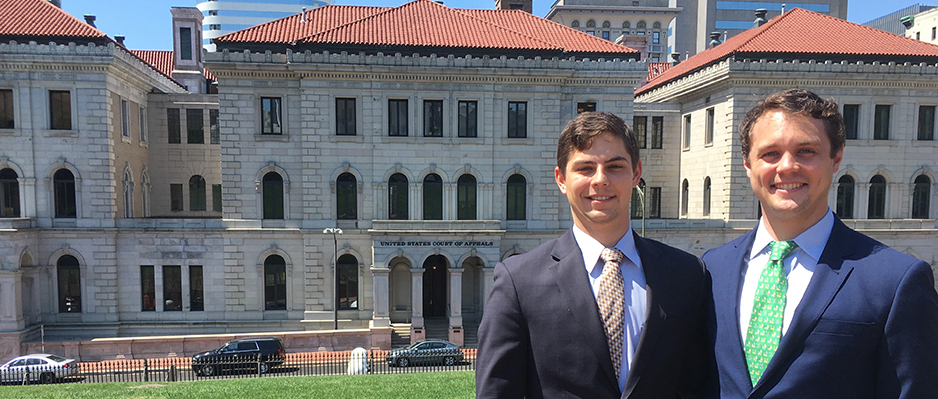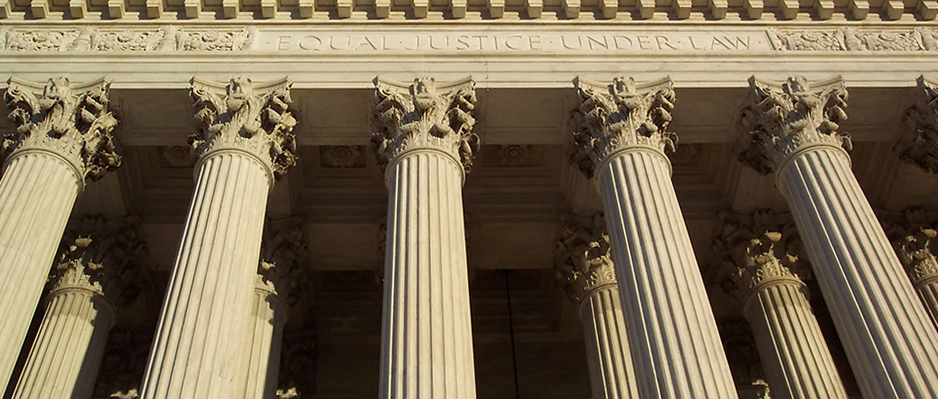About
The UGA School of Law’s Appellate Clinic was founded in 2010, making it one of the older appellate clinics in the country.
Directed by Thomas Burch and Anna Howard, it is a full-year, 6-credit-hour clinic for 3L students.
What Does The Appellate Clinic Do?
Appellate clinics have been a growing presence on law school campuses over the last decade, and as their presence has grown, so has the diversity of their work. At the University of Georgia School of Law, the Appellate Clinic accepts cases from the Board of Immigration Appeals, the Georgia Supreme Court, and the Fourth, Fifth, Ninth, Eleventh, and D.C. Circuits. When needed, it also appears in immigration court and federal district court for matters such as bond determinations and habeas petitions. Overall, the substantive nature of the Clinic’s work varies. Most cases involve immigration, habeas, or Section 1983 claims, but the Clinic has also taken cases involving Title VII, the False Claims Act, and the Georgia Constitution, to name a few.
Working on these cases in a pro bono capacity helps Clinic students recognize the importance of continuing pro bono work in some capacity after graduation. When they prevail in a Section 1983 appeal for an inmate who was assaulted in prison, or win an inmate an opportunity to lodge a new challenge to his conviction, or convince the President to grant an inmate clemency, they see up close the merit in providing indigent representation. In that way, the Clinic improves access to justice beyond just the clients it represents on a year-to-year basis. It has a long-term, lasting effect.
The Clinic also affords students the opportunity to collaborate with faculty members, alumni, and other outside experts to ensure that its clients receive the best possible representation. These outside experts may, for instance, consult at the initial case intake to help the students focus on the right issues. Or they may review draft briefs, giving feedback before the final drafts go to the court. Or they may help students prepare for oral argument, shaping the argument that’s ultimately presented. Whatever the role, these interactions can be some of the most valuable experiences that the Clinic provides to its students because of the long-term relationships that the interactions can foster.
At bottom, the Clinic takes complex cases for indigent clients and give them quality representation. Sometimes that involves addressing technical and complicated habeas questions that may be difficult for a pro se inmate to address on his own. Or sometimes it involves helping an employee pursue a Title VII claim—a type of appointed case that law firms often shy away from taking. Whatever the type of case, the Clinic’s basic mission is to assist indigent clients and courts while preparing students to effectively and professionally practice law after they graduate.
What Do The Clinic Students Do?
The Clinic accepts between 8 and 12 students each year, and it typically assigns 2 to 3 students to each of its cases. Together, the students and the Clinic directors review the record, identify issues to raise, outline the arguments, and draft the opening and reply briefs.
The students usually prepare the initial drafts. The directors then revise, and the students then revise those revisions. This routine repeats itself multiple times, with the number of repeats depending on the complexity of the issues and the quality of the initial drafts. Along the way, the students compile the appendix, ensure compliance with court rules, and update research. The process mirrors the process they will go through when working on similar projects in practice.
Once the briefs are complete, students start preparing for oral argument if argument is granted. That begins with practice arguments before the Clinic directors and other clinic students. Then, once comfortable with the initial practices, the students practice before faculty members, alumni, and other outside experts who graciously volunteer their time. In all, the students may have 8-12 practice arguments before arguing the case to the court of appeals.
Working in a clinic like this is the closest that students will come in law school to seeing what full-time law practice is actually like—all the highs, all the lows, all the demands. That exposure is great for developing the skills needed to meet the expectations that they will face after graduation, and it is a primary reason why taking the Clinic can be so beneficial to students’ future careers and the community at large.
What Are Some of the Clinic’s Recent Cases?
- Brooks v. Jacumin, et al. (4th Cir.). Our client was tased three times in a minute and ten seconds for refusing to have his picture taken during a temporary transfer to the Hill-Finklea Detention Center. His appeal addressed whether that use of force was excessive, whether the district court erred by dismissing the officer who tased him (for failure to serve her with process), and whether the district court should have appointed counsel on his behalf. The Fourth Circuit agreed that the force was excessive and that the tasing officer should not have been dismissed. It then instructed the district court to consider on remand whether appointing counsel would be appropriate.
- In re William R. Gray, Jr. (4th Cir.). A North Carolina state court reduced our client’s capital sentence to a life sentence. Our client subsequently filed an “application for leave” with the Fourth Circuit, asking permission to file a second habeas petition. The Fourth Circuit then appointed us to address whether, given our client’s new sentence, he had to seek authorization to file his new petition. Other courts of appeals had split on that question. The Fourth Circuit agreed with us that our client did not.
- Arellano-Herrera v. Barr (9th Cir.). Our client was convicted for transporting drugs across the border for a prominent cartel. After serving her sentence, she sought deferral of removal under CAT because she fears torture by the cartel if she returns. The IJ found her credible, but denied relief, and the BIA affirmed. We accepted the case on appeal to the Ninth Circuit, and the Ninth Circuit reversed.
- Naranjo-Garcia v. Barr (BIA and 9th Cir.). A prominent cartel killed our client’s husband, stole her property, tried to recruit her son, and twice threatened to kill her. She fled to the U.S., seeking asylum, withholding of removal, and CAT relief. The IJ found her credible, but denied all of her claims. We were appointed to represent her before the BIA, where we lost. We then petitioned the Ninth Circuit for review, and the Ninth Circuit reversed.
- Smith v. Dewberry (11th Cir.). The district court dismissed our client’s Section 1983 complaint (for failure to pay the filing fee) because he had been barred under the three-strike rule from filing any new lawsuits (without paying the filing fee). His appeal addressed whether he met the “imminent danger” exception to the three-strike rule. The Eleventh Circuit agreed with us that he did, reversing and remanding the case to the district court.
- McIlwain v. Burnside, et al. (11th Cir.). Our client filed five grievances against the prison doctor, the prison nurse, and a corrections officer, alleging retaliation and deliberate indifference to a medical need. The district court dismissed three for failure to exhaust, and did not address the other two. The Eleventh Circuit appointed us to represent him on appeal and reversed the district court’s exhaustion ruling.
- Webb v. U.S. Veterans Initiative (D.C. Cir.). Mr. Webb is a military vet who sued USVI under the Fair Housing Act for gender discrimination, claiming that USVI gives female vets preferred treatment in housing choices. The district court dismissed his case by finding (a) that he was not a “renter” under the Act, and (b) that he suffered no injury because he received his apartment rent free. The D.C. Circuit appointed us to argue on Mr. Webb’s behalf, and reversed.
- Williams v. DeKalb County et al. (Ga. S. Ct.). Our client challenged his county commissioners’ sixty-percent pay increase, arguing that it violated the Georgia Constitution and that the commissioners violated the Open Meetings Act when passing it. We were appointed by the Georgia Supreme Court to represent him on appeal. The court remanded for a fact determination on the constitutional question and ruled in our client’s favor on all of the Open Meetings Act claims.
- Iakovlev v. Barr (BIA). Our client was a Russian Jehovah’s Witness who fled his country when it banned his religion. The IJ granted him asylum, and DHS appealed, arguing among other things that he did not submit sufficient corroborating evidence. We agreed to represent him before the BIA, and the BIA affirmed.
- Gutierez v. Barr (BIA). Our client fled a crackdown on people protesting the Nicaraguan government when two of her co-protesters were killed and she was routinely threatened. The IJ granted her withholding of removal, but denied her asylum by retroactively applying the Trump Administration’s asylum transit ban to her case (it was enacted after she first entered the U.S.). A School of Law alum invited us to jointly work on the BIA appeal. The BIA reversed based on a nationwide injunction against the ban.
Course Information & Requirements
Course Information & Requirements
Only third year students are eligible for the clinic, and it is a full year (two semester) clinic.
There are no prerequisites.


